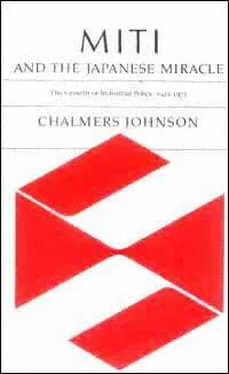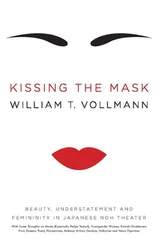Chalmers Johnson - MITI and the Japanese miracle
Здесь есть возможность читать онлайн «Chalmers Johnson - MITI and the Japanese miracle» весь текст электронной книги совершенно бесплатно (целиком полную версию без сокращений). В некоторых случаях можно слушать аудио, скачать через торрент в формате fb2 и присутствует краткое содержание. Год выпуска: 2007, Издательство: Stanford University Press, Жанр: Старинная литература, на английском языке. Описание произведения, (предисловие) а так же отзывы посетителей доступны на портале библиотеки ЛибКат.
- Название:MITI and the Japanese miracle
- Автор:
- Издательство:Stanford University Press
- Жанр:
- Год:2007
- ISBN:нет данных
- Рейтинг книги:3 / 5. Голосов: 1
-
Избранное:Добавить в избранное
- Отзывы:
-
Ваша оценка:
- 60
- 1
- 2
- 3
- 4
- 5
MITI and the Japanese miracle: краткое содержание, описание и аннотация
Предлагаем к чтению аннотацию, описание, краткое содержание или предисловие (зависит от того, что написал сам автор книги «MITI and the Japanese miracle»). Если вы не нашли необходимую информацию о книге — напишите в комментариях, мы постараемся отыскать её.
MITI and the Japanese miracle — читать онлайн бесплатно полную книгу (весь текст) целиком
Ниже представлен текст книги, разбитый по страницам. Система сохранения места последней прочитанной страницы, позволяет с удобством читать онлайн бесплатно книгу «MITI and the Japanese miracle», без необходимости каждый раз заново искать на чём Вы остановились. Поставьте закладку, и сможете в любой момент перейти на страницу, на которой закончили чтение.
Интервал:
Закладка:
10
The big spinnersTeijin, Toray, Kanebo*, and Unitikawere hard enough to control, since they often fell back on the old Osaka tradition of resisting governmental intervention in their affairs; but the smaller manufacturers were even worse. They had borrowed from their banks and invested in their equipment with the full expec-
Page 250
tation that they would receive government-guaranteed allotments of imported raw cotton; the menace of liberalization brought down on the government and the Diet a blizzard of protest from the industry.
During the late 1950's imports of raw cotton and wool took over 20 percent of the foreign exchange budget, a figure higher than that for crude oil during the 1970's. This situation had to change. Moreover, the United States was starting to object to the flood of "dollar blouses" from Japan, and on November 16, 1960, President Eisenhower promulgated his "defense of the dollar" policy, which the Kennedy administration continued. It reduced dollar payments by U.S. forces stationed overseas, put priority on the purchase of American products for U.S. foreign aid programs, and called for negotiations between the U.S. and Japan over limitations on exports of cotton textiles.
As a first step in dealing with these problems, in October 1958 Imai convened a meeting of an informal government-industry discussion group called the Textiles Overall Countermeasures Committee (Sen'i Sogo * Taisaku Kondankai). The key figure on the committee was Horie Shigeo, then president of the Bank of Tokyo (the postwar successor to the Yokohama Specie Bank and the country's main foreign exchange institution). Other members included Oya* Shinzo*, former MCI minister and the president of Teijin; Nakayama Sohei from the Industrial Bank of Japan; Inaba Hidezo*, formerly of the Cabinet Planning Board and in 1958 a leading economic commentator; and other leaders of the textile industry.
Horie spoke often to the group about the moves toward full currency convertibility among the European nations (achieved in December 1958) and of the creation of the European Common Market. He was well informed on the recent shift by Germany and England to "article 8 status" in the IMF, which required an end to restrictions on payments for current transactions and on the convertibility of currency held by nonresidents; and he said that Japan as a nation that had to trade to live could not lag far behind its trading partners and competitors. Upon becoming MITI minister in June 1959, Ikeda attended the committee meetings, where he was quoted as saying, "Mr. Horie knows what he's talking about in terms of global trends."
11
In December 1959, on the basis of the committee's deliberations and Imai's recommendation, Ikeda took his first liberalization decision: he freed raw cotton and wool imports from all governmental restrictions. This was a powerful precedent. In January 1960 the government established a Cabinet Council on the Advancement of Trade Liberalization (Boeki* Jiyuka* Sokushin Kakuryo* Kaigi) to prepare liberalization plans for other industries, and this in turn led on March 8, 1960, to a
Page 251
great debate at a MITI ministerial conference called to discuss liberalization. According to the report of Komatsu Yugoro *, Matsuo Taiichiro*, then director of the International Trade Bureau, was alone in speaking in favor of the policy. Imai did not have to speak; he was already identified with liberalizationa hero to some and a near traitor to others.
12
He had, however, clearly won the trust and confidence of the MITI minister, who was soon to become prime minister.
Imai himself has noted that liberalization was as much a political and administrative problem as an economic one. He favored it because of his personal dislike for the controlled economy, a dislike that grew out of the occupation. But he also saw liberalization as an opportunity to move Japan toward an industrial structure with fewer enterprises overall, but with more, proportionately, in high-technology industries, and in this his position and Sahashi's coincided. Within the ministry as a whole, however, young officials thought that liberalization would mean the end of their jobs, senior officials in the vertical bureaus were worried about the structural weaknesses of their industries, and politicians feared for their reelection. Ikeda persisted nonetheless. In June the outgoing Kishi cabinet adopted Ikeda's trade liberalization plan, which set the goal of an economy that would be 80 percent liberalized within three years.
The figure of 80 percent was to be calculated according to the commodities and products listed on the Brussels Customs Schedule. On this basis, the rate of import liberalization, which in April 1956 stood at 22 percent, had been raised by April 1960 to 41 percent. The plan's 80 percent liberalization was to be attained by fiscal 1963, the initial target for 1961 being set at 62 percent. The mere publication of these figures set off a complicated process of jockeying by each industry (and its MITI bureau) to have the lifting of its controls scheduled late rather than early. Shiroyama suggests in his novel that Ikeda actually began with cotton and wool because these industries were heavy contributors to his political rivals, although Imai never mentions this as a consideration.
13
It is hard to recapture today the crisis atmosphere that existed in Japanese industrial circles during 1961. The press prattled on endlessly about "the second coming of the black ships," "the defenselessness of the Japanese islands in the face of attack from huge foreign capitalist powers," and "the readying of the Japanese economy for a bloodstained battle between national capital and foreign capital."
14
Sahashi himself invoked the name of the National General Mobilization Law of 1938 and said that Japan again required a "national general mobilization'' in order to create an economic system that could with-
Page 252
stand the rigors of international competition.
15
As it turned out, the crisis was considerably overstatedfrom 1960 to 1965 exports more than doubled on a customs-clearance basis (from $4 billion to $8.7 billion), suggesting the existence of substantial international competitive strength in the economy. Nonetheless, the sense of crisis was real, and it may well have helped to motivate the economy's export performance.
The Ikeda government took many measures intended to relieve the widespread anxiety. In 1960 it created the Asian Economic Research Institute as a government organ concerned with the study of markets in underdeveloped countries, and in 1961 it set up the Overseas Economic Cooperation Fund to disburse foreign aid. Both agencies were promoted abroad as evidence of Japan's expanding contributions to allied foreign aid efforts, but domestically they were justified as export promotion agencies, since the aid Japan gave would be tied to purchases of Japanese plants and equipment. During 1960 the government also revised tariff rates and schedules to offer greater protection to liberalized industries, and it expanded the capital of the Export-Import Bank in order to finance more exports.
The most famous of the government's calmatives was Ikeda's Income-doubling Plan, formally adopted by the cabinet on December 27, 1960. The plan itself was wildly overfulfilled, and its chief importance in retrospect was the psychological effect it had in creating optimism about the future to counterbalance the pessimism about liberalization coming from the press and MITI. The Income-doubling Plan did, however, have one important bureaucratic consequence. Ikeda had assigned to the Economic Planning Agency the task of drafting the plan, and the publicity surrounding the EPA's efforts gave its so-called agency economiststhat is, career officials of the EPA rather than transferees from MITI or Financea chance to try to break free of MITI's dominance. The EPA sought to name one of its own officials, the prominent economist and future foreign minister Okita* Saburo*, to be vice-minister of the agency, rather than accept another senior MITI official. MITI successfully beat back this attempt, but in the process it had to make the EPA post a terminal position in the MITI chain of command; a MITI official sent to the EPA as vice-minister could no longer return to the ministry. As we shall see, this was important because it gave Sahashi the chance to eliminate two final rivals in his quest for the MITI vice-ministership by seeing to it that the MITI minister appointed them EPA vice-minister, where they would be out of the running for the big prize.
Читать дальшеИнтервал:
Закладка:
Похожие книги на «MITI and the Japanese miracle»
Представляем Вашему вниманию похожие книги на «MITI and the Japanese miracle» списком для выбора. Мы отобрали схожую по названию и смыслу литературу в надежде предоставить читателям больше вариантов отыскать новые, интересные, ещё непрочитанные произведения.
Обсуждение, отзывы о книге «MITI and the Japanese miracle» и просто собственные мнения читателей. Оставьте ваши комментарии, напишите, что Вы думаете о произведении, его смысле или главных героях. Укажите что конкретно понравилось, а что нет, и почему Вы так считаете.












